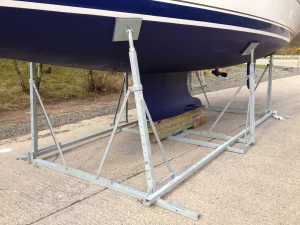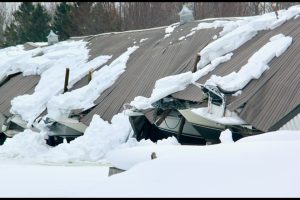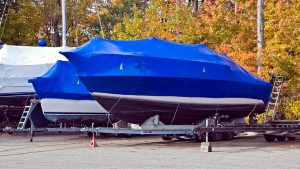Protecting Your Boat and Insurance Considerations
As the boating season winds down in Canada and the chill of winter approaches, it’s time for Canadian boat owners to start thinking about haul-out and winterization. Properly preparing your vessel for the off-season is essential to ensure it remains in top condition and ready for the next season. However, winterization isn’t just about maintenance—it’s also about protecting your investment, which includes maintaining the right insurance coverage. In this article, we’ll explore the key steps for winterizing your boat, the importance of keeping vermin out, and why insurance coverage during the off-season is critical. We’ll also touch on the lessons learned from recent snowload incidents at storage facilities and how to ensure your marina is prepared.
The Basics of Haul-Out and Winterization
Lifting, Blocking, and Cradling

When it’s time to haul your boat out of the water, marinas and yacht clubs typically use a travel lift or crane with slings. Proper lifting is crucial to avoid damage to the hull. Here are some key considerations:
- Sling Placement: Ensure slings are positioned to avoid underwater machinery, transducers, and through-hulls. They should also be backed by bulkheads for added support.
- Stability on Land: Once lifted, the boat is placed on blocks or a cradle. The keel should bear the weight, while support blocks or cradle pads keep the boat level. The boat should be slightly bow-up to allow water drainage.
- Ground Conditions: Use plates or wood under stands and blocks to prevent sinking during spring thaw.
- Minimize Interior Weight: Remove excess gear and ensure water and snow cannot accumulate inside.
Trailering and Trailer Maintenance
If you’re using a trailer for storage, ensure it’s in good condition:
- Drain Water: Remove the drain plug and position the boat to allow water to drain.
- Wheel Bearings and Tires: Add grease to wheel bearings, inflate tires, and block wheels for stability.
- Sun and Weather Protection: Trailers are exposed to the elements, so inspect for wear and tear and address any issues before winter.
Winterizing
Leave this to pros as most policies require you to hire a professional to winterize your boat. Every year your boat needs to winterized, even it was not used during the season. This includes:
Drives and Outboards
Drives and outboards are self-draining, but only if positioned correctly:
- Trim Position: Set the engine or drive trimmed up during transport, but lower it to a vertical or negative angle for storage to ensure complete drainage.
- Change Lower Unit Oil: Before storing your boat, drain and replace the lower unit oil. This prevents water contamination from freezing and causing damage to the gears or seals.
Lorem ipsum dolor sit amet, consectetur adipiscing elit. Ut elit tellus, luctus nec ullamcorper mattis, pulvinar dapibus leo.
Engine and Equipment
- Change Engine Oil: It’s also a good idea to change the engine oil before winter storage. Old oil can contain contaminants that may corrode internal engine components over time. Fresh oil ensures your engine is protected during the off-season.
- Disconnect and drain any water from hoses, pumps, and livewells. Inspect and lubricate moving parts, such as steering cables and throttle linkages, to prevent seizing during storage.
- Flush the engine with fresh water to remove salt, dirt, and debris. Then, run antifreeze through the cooling system to prevent freezing and corrosion. Finally, fog the engine by spraying fogging oil into the carburetor or intake while the engine is running. This coats internal components with a protective layer to prevent rust.
Battery Care
There’s ongoing debate about whether to remove batteries or leave them aboard, but two points are non-negotiable:
- Fully Charged: A fully charged battery won’t freeze, while a discharged one can be damaged in cold temperatures.
- Disconnected: Disconnect the battery to prevent accidental discharge
Covers, Tarps, and Ventilation
Drainage
Remove all bilge, transom, garboard, and livewell plugs to allow water to drain freely. This reduces the risk of water intrusion and freezing damage.
Keeping Vermin Out of Your Boat
One often-overlooked aspect of winterization is protecting your boat from vermin. Rodents and other pests can cause significant damage by chewing through wiring, upholstery, and other materials. Here are some tips to keep them out:
- Seal Entry Points: Inspect your boat for gaps or openings and seal them with steel wool or foam.
- Remove Food and Scented Items: Even small crumbs or scented cleaning products can attract pests.
- Use Repellents: Place rodent repellents or traps in and around your boat.
- Check Your Insurance Policy: Not all insurance policies cover damage caused by vermin. Consider purchasing a policy that includes vermin coverage to protect against unexpected repair costs.
Snowload Risks: Lessons from Last Season

Last winter, several storage facilities experienced structural failures due to heavy snowloads, resulting in significant damage to boats. This highlights the importance of asking your marina about their snowload management plan. Here are some questions to consider:
- Snow Removal Procedures: Does the marina have a plan for clearing snow from storage structures?
- Structural Integrity: Are the storage facilities inspected and reinforced to handle heavy snow?
- Insurance Requirements: Does the marina require you to carry specific insurance coverage for stored boats?
By addressing these questions, you can ensure your boat is stored in a safe environment and reduce the risk of damage.
The Importance of Insurance During the Off-Season
Many boat owners mistakenly believe they can cancel or reduce their insurance coverage during the off-season. However, this can leave you vulnerable to significant financial losses. Here’s why maintaining insurance is essential:
- Year-Round Risks: Even when stored, your boat is at risk of theft, fire, vandalism, and weather-related damage.
- Liability Coverage: If someone is injured while working on or near your boat, liability coverage can protect you from legal and medical expenses.
- Items removed for storage: most boat policies include coverage for machinery, gear, equipment, furniture, fittings and other property to be stored away from your boat while laid up. Referred to as ‘Equipment on Shore’ limits apply to the items removed and reduces the amount of insurance for you boat.
- Vermin Damage: As mentioned earlier, vermin can cause costly damage. Ensure your policy includes coverage for this risk.
Conclusion
Haul-out and winterization are critical steps in protecting your boat during the off-season. From proper lifting and storage techniques to keeping vermin out and maintaining insurance coverage, every detail matters. Don’t overlook the importance of asking your marina about their snowload management plan, especially in light of recent incidents. By taking these precautions, you can safeguard your investment and enjoy peace of mind throughout the winter months.
Remember, a well-maintained and properly insured boat is the key to a stress-free start to the next boating season.
We welcome the opportunity to review your coverage and help you ensure your boat is fully protected year round. Contact Gallagher Skippers’ Plan at 1.800.661.7211 or visit us online at https://skippersplan.com. Happy winterizing!

